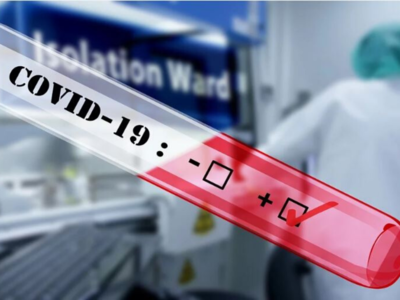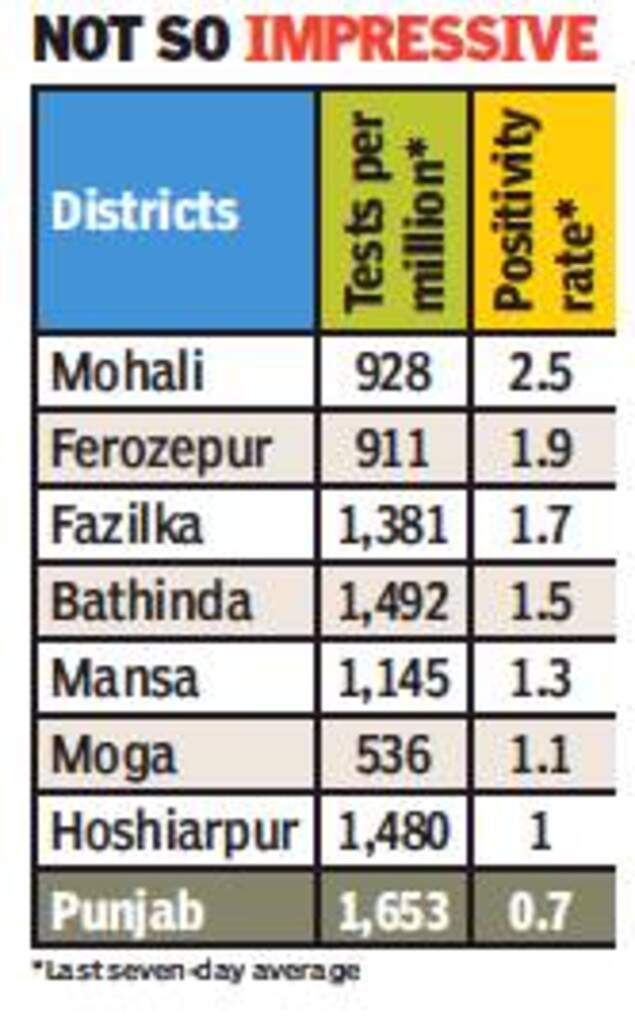- News
- City News
- chandigarh News
- Low testing in Punjab districts with positivity rate above state’s average
Low testing in Punjab districts with positivity rate above state’s average

Picture used for representational purpose only
CHANDIGARH: Punjab districts with a positivity rate higher than the state’s average are not testing enough. The rate of testing in these districts is below the state’s overall test per million population and some of them even failed to match the national average, which is way less than Punjab’s average testing.
With the fast-spreading highly infectious Delta variant (B.1.6.17) of Covid-19 becoming the most dominating variant of concern, low testing and high positivity ratio in these districts have emerged as a cause of concern for the health authorities.

The state’s overall figure of 1,653 tests per million population is higher than the national seven-day average of 1,405 tests. The data of the Punjab health department reveals that as many as 13 districts are testing less than the state average, of which seven districts have a positivity rate higher than the state's overall average.
Worst-performing districts told to increase testing
Mohali district that recorded the highest positivity rate of 2.5% this week conducted only 928 tests per million population during the last seven-day period on an average. Punjab’s weekly positivity rate, which refers to the percentage of people who are Covid-19 positive out of total tested, stands at 0.7%.
Ferozepur is the second worst ¦ -performing district with a positivity rate of 1.9%, which is more than the state’s average. The district conducted 911 tests per million population in the last seven days. In Fazilka, 1,381 tests per million were conducted and 1.7% of samples tested positive. In Bathinda, 1,492 tests per million were conducted and the weekly positivity rate was recorded at 1.5%.
Taking note of low testing and high positivity, the health department has directed these districts to increase testing on priority and also to ascertain the reasons for positivity being higher than the state's average.
Punjab is using reverse transcription-polymerase chain reaction (RT-PCR) and rapid antigen test for detecting Covid-19. Testing is considered the most important factor in controlling the spread of the virus by identifying infected people early and isolating them. RT-PCR testing capacity of state government laboratories has increased from 26,750 as of January 2021 to 45,500 in June.
Since the beginning of the pandemic, 1,07,95,548 samples have been tested in Punjab which implies that over 36% of the state’s population has been tested. For every lakh people, as many as 36,155 samples have been tested so far. Punjab is faring a little better than the neighbouring states of Haryana (34,787.7 tests per lakh) and Himachal Pradesh (33,019 tests per lakh).
With the fast-spreading highly infectious Delta variant (B.1.6.17) of Covid-19 becoming the most dominating variant of concern, low testing and high positivity ratio in these districts have emerged as a cause of concern for the health authorities.

The state’s overall figure of 1,653 tests per million population is higher than the national seven-day average of 1,405 tests. The data of the Punjab health department reveals that as many as 13 districts are testing less than the state average, of which seven districts have a positivity rate higher than the state's overall average.
Worst-performing districts told to increase testing
Mohali district that recorded the highest positivity rate of 2.5% this week conducted only 928 tests per million population during the last seven-day period on an average. Punjab’s weekly positivity rate, which refers to the percentage of people who are Covid-19 positive out of total tested, stands at 0.7%.
Ferozepur is the second worst ¦ -performing district with a positivity rate of 1.9%, which is more than the state’s average. The district conducted 911 tests per million population in the last seven days. In Fazilka, 1,381 tests per million were conducted and 1.7% of samples tested positive. In Bathinda, 1,492 tests per million were conducted and the weekly positivity rate was recorded at 1.5%.
Taking note of low testing and high positivity, the health department has directed these districts to increase testing on priority and also to ascertain the reasons for positivity being higher than the state's average.
Punjab is using reverse transcription-polymerase chain reaction (RT-PCR) and rapid antigen test for detecting Covid-19. Testing is considered the most important factor in controlling the spread of the virus by identifying infected people early and isolating them. RT-PCR testing capacity of state government laboratories has increased from 26,750 as of January 2021 to 45,500 in June.
Since the beginning of the pandemic, 1,07,95,548 samples have been tested in Punjab which implies that over 36% of the state’s population has been tested. For every lakh people, as many as 36,155 samples have been tested so far. Punjab is faring a little better than the neighbouring states of Haryana (34,787.7 tests per lakh) and Himachal Pradesh (33,019 tests per lakh).
FacebookTwitterLinkedinEMail
Start a Conversation
end of article
Quick Links
Delhi Air PollutionDelhi TemperatureChennai WeatherBangalore TemperatureCovid vaccination centres in DelhiCoronavirus in DelhiRTPCR test in GurgaonHyderabad RainPollution level in BangaloreDelhi SmogDelhi TemperatureNoida AQIGurgaon AQI todayFire in MumbaiMumbai RainsCovid 19 RT PCR Test in NoidaDelhi AQI todaySrinagar encounter
